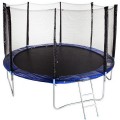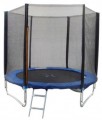Maximum weight
The greatest load that a trampoline is designed for, in other words, the total weight of people that it is able to transfer without consequences. This parameter is one of the main when choosing a trampoline. In no case should you exceed the maximum load, this is fraught with equipment breakdowns and serious injuries to athletes (moreover, such a nuisance can occur after exposure to an abnormal load, under a completely permissible weight). Accordingly, when choosing, it is worthwhile to clearly determine the maximum load that the product can be subjected to.
High maximum load values are especially important when installed in trampoline centers, gyms and other public places where the circle of potential athletes is unlimited, and among them there may be people of a very large build.
Trampoline size (LxWxH)
The overall size of the trampoline; in this case, the height can be measured both by the height of the working surface, without taking into account the protective grid and other additional devices, and by the overall dimensions of the product in the working position. Also note that the size of the working area on the canvas is usually less than the overall dimensions in length and width — there is protection along the edges that covers the springs, and it is undesirable to jump on it.
Mesh height
The height of the regular trampoline protective net (see "Complete set"). This height is usually measured from the working surface, which allows you to evaluate the protective properties of the mesh. The higher it is, the better, but in general it is desirable that the height is not lower than the height of the intended user (or at least slightly lower).
Number of springs
The number of springs provided in the design of the trampoline of the corresponding type (see above).
The smaller the springs, the larger and thicker each of them must be in order to normally carry their “portion” of the load. However manufacturers usually choose the thickness and quantity in such a way as to achieve the required performance. Therefore, from the user's point of view, there is no key difference between an abundance of small springs and a few large ones, and this parameter, in fact, is purely reference.
In box
—
Protective mesh. A rather high net, stretched around the perimeter of the trampoline and designed to prevent falling over its edge, which is fraught with injuries. Note that such a device is not a 100% guarantee and does not eliminate the need to be careful. However, it markedly reduces the chance of "going overboard"; and if the product is purchased for children, the presence of a net in the kit is highly desirable. However, if necessary, the trampoline can be used without it.
—
Handle for support. A handle that a person on a trampoline can hold on to while jumping. This feature is quite popular in fitness models (see "Type"), it makes it easier to perform some specific exercises. Also, the pen can be useful for novice users who do not have the skill of jumping on a trampoline — as an additional insurance.
—
Staircase. A small ladder that facilitates the ascent to the working surface of the trampoline. Such a surface can be located at a height of several tens of centimeters, which can create serious inconvenience for some users (for example, children). Of course, for the convenience of lifting, you can also use improvised devices (for example, build "steps" from a pair of boxes of different heights), but a complete ladder is usually more convenient, more compact, and often safer.
—
Gorka. A classic slopi
...ng slide that kids can slide down while playing. It is found exclusively in inflatable models (see "Type"), in other types of trampolines, it is not only technically difficult to provide such a feature, but it is generally pointless. And some slides are made "water" — they can be poured with water from nozzles built right into the trampoline, which is indispensable for playing on a hot summer day.
— Water effect. Possibility to water the trampoline. This possibility is provided only in inflatable models (see "Type"). Such products are used not so much as trampolines as such, but as entertainment structures; they have a jump zone, but, in addition to it, the design usually provides for a slide, and other devices can also be used — for example, a water cannon for games, a shallow “splash pool”, etc. A special nozzle in the upper part is usually responsible for supplying water, which plays the role of a “shower” (including for players). The water effect performs two functions: firstly, it refreshes in hot weather, and secondly, it makes the trampoline is more slippery (this is true for downhill slides.).
— Air blower. The air blower is a very important piece of equipment for many inflatable trampolines (see "Type"): during operation, they maintain pressure in the shell. At the same time, we note that, unlike many inflatable structures, trampolines with superchargers are not hermetic: air is constantly supplied from the compressor and bled through the outlet. This provides the necessary elasticity and at the same time protects the shell from sudden pressure drops (especially when jumping), reducing the likelihood of damage: excess air simply fly out. The absence of a supercharger in an inflatable trampoline kit, usually, means that we have before us the simplest model for the smallest children, often not designed for jumping at all.
— Repair kit .. Kit for repairing damage to the inflatable shell in a trampoline of the corresponding type (see above). The main element of such a kit are patches that can be self-adhesive or attached using the composition supplied in the kit. Other elements may also be included in the set. However, anyway, using such a kit for repair is more convenient and reliable than using a “non-native” one: the standard kit is optimally suited for a specific shell.
— Tools. Tools can be completed with frame trampolines and models for fitness (see "Type"). Such products are usually disassembled for storage and transportation, and must be assembled before use. To do this, tools are provided in the kit — usually, the simplest ones, such as wrenches for standard nut sizes used in the design. Despite their simplicity, such devices are optimally suited for this product and may be more convenient than third-party tools; and if the latter are absent nearby, this feature turns out to be indispensable in general.
— Case. Case designed for storage and transportation of the trampoline. Protects the product from dust, dirt, moisture and other adverse effects, as well as from unwanted contact with surrounding objects. For these purposes, you can use third-party cases, including self-made, however, a complete case, usually, is more convenient and reliable.
